
How to become a Blockchain developer
I. Introduction to Blockchain development
Blockchain technology has revolutionized various industries, from finance to supply chain management. At its core, a Blockchain is a decentralized and immutable digital ledger that records transactions in a secure and transparent manner. As the world embraces the potential of Blockchain, the demand for skilled Blockchain developers is skyrocketing, opening up a plethora of opportunities in this cutting-edge field. Blockchain developers play a pivotal role in creating, implementing, and maintaining Blockchain solutions that power the next generation of applications.
III. Prerequisites for Blockchain development
Before diving into the world of Blockchain development, it’s essential to build a strong foundation in several key areas. Basic programming knowledge is the first step, as proficiency in languages like Java, C++, and Python is fundamental. Understanding data structures and algorithms is crucial for optimizing the performance of Blockchain applications. Additionally, familiarity with cryptography is necessary to ensure the security and integrity of transactions. Proficiency in version control systems, such as Git, enables efficient collaboration within development teams.
III. Essential programming languages
Different aspects of Blockchain development require different programming languages. Solidity is a must-know language for Ethereum development, allowing developers to create smart contracts. JavaScript is pivotal for building engaging front-end interfaces for Blockchain applications, while Python is commonly used for writing smart contracts. For core Blockchain development, languages like Go and Rust offer the speed and reliability required for building robust networks.
IV. Learning Blockchain basics
A solid understanding of Blockchain fundamentals sets the stage for a successful developer journey. Distributed ledger technology forms the backbone of Blockchain, enabling transparent and decentralized record-keeping. Consensus mechanisms like Proof of Work and Proof of Stake ensure agreement on the state of the Blockchain. Smart contracts, self-executing contracts with predefined rules, are a cornerstone of Blockchain applications. Decentralized applications (DApps) leverage these components to offer innovative solutions across industries.
V. Getting started with Blockchain platforms
Ethereum, the pioneer of smart contract platforms, provides an ideal starting point for aspiring Blockchain developers. Its extensive ecosystem offers tools and resources for building decentralized applications. Other platforms like Binance Smart Chain and Cardano also present unique opportunities. Setting up development environments using tools like Ganache, Remix, and Truffle streamlines the development process, allowing developers to test and deploy their creations seamlessly.
VI. Smart contract development
Writing, compiling, and deploying smart contracts is a crucial skill for Blockchain developers. Solidity’s syntax and best practices guide developers in creating secure and efficient smart contracts. Interacting with these contracts is made possible through libraries like web3.js or ethers.js, enabling seamless integration of Blockchain functionality into applications.
VII. Blockchain security
Security is paramount in Blockchain development, given the potential consequences of vulnerabilities. Embracing secure coding practices is imperative to prevent exploits. Common vulnerabilities like reentrancy and overflow require meticulous attention. Tools like MythX and Securify aid in auditing smart contracts, identifying vulnerabilities before deployment and ensuring the integrity of Blockchain systems.
VIII. Building decentralized applications (DApps)
The user interface of a decentralized application plays a crucial role in its adoption. Front-end development for DApps requires proficiency in HTML, CSS, and JavaScript. Integrating the DApp with the Blockchain is achieved through APIs, enabling communication between the user interface and the Blockchain. Web3 libraries simplify this interaction, abstracting complex Blockchain operations for developers.
IX. Version control and collaboration
Efficient collaboration is key to successful Blockchain development. Git, a powerful version control system, facilitates seamless teamwork by tracking changes and allowing developers to work on different features simultaneously. Platforms like GitHub provide a central hub for hosting repositories, fostering collaboration within the developer community.
X. Advanced topics in Blockchain
As developers gain expertise, exploring advanced topics becomes essential. Privacy and confidentiality mechanisms are crucial for industries like healthcare and finance, ensuring sensitive data remains secure. Cross-chain interoperability addresses the challenge of different Blockchains communicating with each other. Layer 2 scaling solutions tackle the scalability issue, enabling Blockchains to handle a higher volume of transactions.
Becoming a Blockchain developer is a rewarding journey that requires dedication and continuous learning. By mastering programming languages, understanding Blockchain fundamentals, and embracing security practices, aspiring developers can thrive in this dynamic field. The evolution of Blockchain technology promises ongoing innovation, making it an exciting time to embark on this path. As demand continues to rise, Blockchain developers are poised to shape the future of technology.


